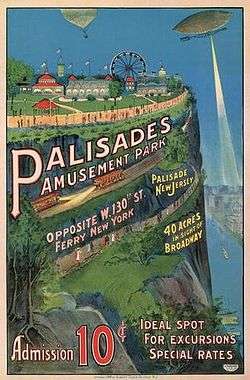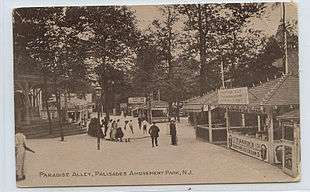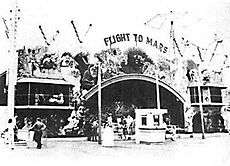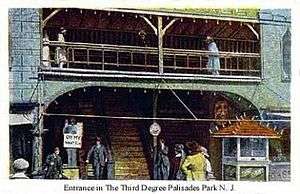Palisades Amusement Park
 | |
| Slogan | Come on over! |
|---|---|
| Location | Cliffside Park-Fort Lee, New Jersey, U.S. |
| Coordinates | 40°49′41″N 73°58′40″W / 40.8281°N 73.9778°WCoordinates: 40°49′41″N 73°58′40″W / 40.8281°N 73.9778°W |
| Owner | Nicholas and Joseph Schenck, Jack and Irving Rosenthal |
| Opened | 1898 |
| Closed | September 12, 1971 |
| Previous names | Park on the Palisades, Schenck Brothers Palisade Park |
| Operating season | Weekend before Easter to Sunday after Labor Day |
| Area | New York metropolitan area |
| Rides | |
| Total | 45-50 (rides varied from season to season) |
| Roller coasters | 5 |
| Website |
www |
Palisades Amusement Park was a thirty-acre amusement park located in Bergen County, New Jersey, across the Hudson River from New York City. It was located atop the New Jersey Palisades lying partly in Cliffside Park and partly in Fort Lee. The park operated from 1898 until 1971, remaining one of the most visited amusement parks in the country until the end of its existence. After the park closed in 1971, a high-rise luxury apartment complex was built on its site.
The Trolley Park Era: 1898-1910
Throughout its entire history the park overlooked the Hudson River: thirty acres of New Jersey riverfront land straddling what is now Cliffside Park and Fort Lee, and facing the northern end of Manhattan.
In 1898, before common use of automobiles, the Bergen County Traction Company conceived the park as a trolley park to attract evening and weekend riders. It was originally known as "The Park on the Palisades".
In 1908, the trolley company sold the park to August Neumann and Frank Knox, who hired Alven H. Dexter to manage it. Dexter imported a crude assortment of attractions which included a Ferris wheel, a baby parade, and diving horses.[1]
The Schenck Brothers: 1910-1934
By 1908, the park was renamed Palisades Amusement Park, and the new owners began adding amusement rides and attractions.
In 1910, the park was purchased by Nicholas and Joseph Schenck and their Realty Trust Company.[1][2] The Schencks were brothers who were active in the nascent motion picture industry in nearby Fort Lee.[1] They renamed the park once again, naming it Schenck Bros. Palisade Park.
In 1912, the park added a salt-water swimming pool.[1] It was filled by pumping water from the saline Hudson River, 200 feet (60 m) below. This pool, 400 by 600 feet (120 meters by 180 meters) in surface area, was advertised as the largest salt-water wave pool in the nation. Behind the water falls were huge pontoons that rose up and down as they rotated, creating a one-foot wave in the pool.
As the park added more and more attractions, it became so famous by the 1920s that the Borough of Palisades Park, located just west of the amusement park, actually considered changing its name to avoid visitors' confusion.
In 1928 the park introduced the third of Harry Traver's Cyclone roller coasters. Due to the high maintenance costs, the ride lasted only six years before being removed.
The Rosenthal Brothers: 1934-1971

In 1934 or 1935, Nicholas and Joseph Schenck sold the site for $450,000 to Jack Rosenthal and Irving Rosenthal.[1][2][3] The Brooklyn brothers and entrepreneurs had made a fortune as concessionaires at Coney Island. They also owned some concessions and a carousel at Savin Rock Park in Connecticut. The Coney Island Cyclone roller coaster was built by the Rosenthals in 1927, and is still operating (not to be confused with any of the Traver Cyclones).
In 1935 the park was partially destroyed by fire, and in 1944 a second fire erupted. The fire closed the park until the start of the 1945 season.[2][4]
The Rosenthals restored the park's previous and most recognizable name, Palisades Amusement Park. At the start of World War II, the Rosenthals sold the Cyclone coaster at Coney Island to Silvio Pinto who operated until it was sold to the city of New York in 1969. The city put it up for a bid for someone to operate it in 1974 and Jerry Alberts from Astroland won the bid and operated the ride until Astroland's closure after the 2008 season.

One of the many attractions, rebuilt and redesigned by construction superintendent Joe McKee, included the Skyrocket roller coaster. The Rosenthals named the newly repaired coaster the Cyclone after their beloved Coney Island coaster. Later, in 1958, Joe built the Wild Mouse roller coaster with his construction foreman Bert Whitworth,.
The park's reputation and attendance continued to grow throughout the 1950s and 1960s, largely due to saturation advertising and the continued success of the park's music pavilion and Caisson bar erected during the Schencks' ownership era.
During the mid-1950s the park started featuring rock and roll shows hosted by local radio announcers Clay Cole and "Cousin Brucie" Morrow, and starting during the 1960s, Motown musical acts were performed there. The park's renown extended far beyond the New York City metropolitan area, as advertisements for it were frequently printed in the back pages of 1950s and 1960s comic books.
The Rosenthals realized that NYC-area youths represented the largest single market for comic books in the nation, and that comic book advertising was a cheap way to reach thousands of potential customers.
Segregation history
Several African-Americans began to challenge Palisades Amusement Park pool’s racial segregation during the summer of 1946. Protesters showed up at the Palisade Avenue entrance to the park with signs in hand, some reading “Protest Jim Crow”, Jim Crow meaning state and local laws enacted between 1876 and 1965, entirely by Democrats, mandating racial segregation in public facilities.
The park established the Sun and Surf Club and only members were admitted into the saltwater pool. According to Vince Gargiulo in his book, Palisades Amusement Park: A Century of Fond Memories...“In reality, the club allowed park officials to discriminate according to the color of the patron’s skin. In July 1946, ten people, eight black and two white, visited the Park as a group. The two whites were sold tickets for the swimming pool while all the blacks were refused admission. The following month, the American Civil Liberties Union requested the Bergen County Grand Jury to investigate the Park’s admission policy for the pool. This was the beginning of a controversy that would drag on for several seasons. By the time the Park closed for 1946, the grand jury still had not acted upon the petition from the ACLU. But the Rosenthals' hopes that the issue would disappear from the headlines were swiftly shattered the following season.”
During the summer of 1947 the protests continued and became larger. Melba Valle, a 22-year-old African-American woman from New York, attempted to gain admission to the pool using a ticket purchased by her friend who was caucasian on the morning of July 13, 1947. The ticket in Valle’s hands was not honored and she was denied admission to the pool. According to newspaper accounts Valle was “forcibly dragged and ejected” from the Park. This discrimination resulted in demonstrations at the Park gates by the Congress of Racial Equality (CORE). Less than a month after Ms. Valle’s ejection from the Park, eleven members of CORE were arrested. Demonstrators vowed to return to protest at the Park gates every Sunday until Blacks were admitted entrance to the pool.
Below is the content of a flyer from 1947 handed out by the protesters – the flyer is on exhibit in the Fort Lee Museum:
DON’T GET COOL
AT PALISADES POOL Palisades Pool, in violation of the New Jersey Civil Rights Law, bars Negroes and persons with dark skins. Such a person is told that a club exists and only members can use the pool. Yet white persons who are not “members” are regularly admitted and then handed a “membership” card inside. Irving Rosenthal, the Park’s owner, refused to cease racial discrimination, although it violates the New Jersey law. Members of our interracial group who tried peacefully to gain admittance to the pool have been manhandled by the Park’s private guards and by Fort Lee police. On July 27 of that year, a Negro was blackjacked from behind by a park representative while other park “goons” were shoving him on a bus. On August 3, eleven of the CORE group were arrested on trumped up charges, and two were beaten by the police.
"The time has come to end this reign of terror" they wrote. Rosenthal, by the early 1950s, decided that this policy could no longer be applied.[5]
The "Palisades Park" song

In 1962 Chuck Barris composed and Freddy Cannon first recorded a song about the park, Palisades Park. The song was an up-tempo rock and roll tune initiated by a distinctive organ part. The song also incorporated amusement park sound effects. "Palisades Park" received nationwide radioplay and increased the park's fame even more.
Boom in popularity

The "Palisades Park" song generated a huge surge of visitors to the park. Additionally, behind the Palisade Park music stage was the park's worst-kept secret: a hole in the fence used by local children to sneak into the park without paying admission. Despite the fact that the Rosenthal brothers knew all about this breach, it was purposely left unrepaired. Unlike more modern amusement parks that sell unlimited ride passes, Palisades Amusement Park charged individual fees for each ride and attraction inside the park in addition to the entrance fee. Feeling that children, who had little money to start with, would be more willing to spend it once inside if they had more left after entering, Irving Rosenthal, a man who loved children even though he had none of his own, allowed this "secret" entrance to remain and instructed security personnel to ignore anyone sneaking through it.
The same thinking caused Rosenthal to saturate the market with free-admission offers printed on matchbooks and in other places. He owned an advertising company that put up billboards known as "three sheeters" all over New York City. Parking was free for the same reasons, but as the park began attracting bigger and bigger crowds in later years, the onsite parking lot became less and less adequate, often rapidly filling to capacity.
An overflow parking lot was opened at the bottom of the cliff in Edgewater, NJ with shuttle buses carrying visitors up to the park. Once the lots were full on weekends, traffic coming from the George Washington Bridge would be sent down the road towards the Lincoln Tunnel and the traffic coming from the tunnel would be sent towards the bridge, with no real place to go. Consequently many visitors were forced to park their vehicles wherever they could find a spot on nearby side streets (in some cases, as much as several miles away) and near local business establishments, clogging traffic and occupying street parking spaces, much to the great frustration of many area residents.
Demise
Two factors contributed to the eventual closing of Palisades Amusement Park: near-gridlock traffic conditions in its vicinity due to inadequate parking facilities, and growing uncertainty about its future.
By 1967, Jack Rosenthal had died of Parkinson's disease leaving his brother Irving as sole owner.[6] Irving, in his 70s, was not expected to manage the park for much longer and without family heirs, it was unclear as to who would eventually assume ownership. Meanwhile the park had become so popular that the towns of Cliffside Park and Fort Lee were being overwhelmed by the hordes of people who were "coming on over" in response to the park's advertisements, and the traffic situation had become worse.
Local residents, tired of the traffic jams, litter and other problems (e.g., changing racial demographics) caused by the park's immense popularity, demanded action from local elected officials. Developers hoped for an opportunity to profit by the Palisades' spectacular view of Manhattan, and they successfully pressured the local government to re-zone the amusement park site for high-rise apartment housing and condemn it under eminent domain.
During the next few years, the land was surveyed by a number of builders who made lucrative offers, but Rosenthal tried to postpone the park's inevitable closing and refused to sell. During the heyday of "Palisades Park" in the 1950s and 1960s, Mr. Irving, as he was called at work, would refer to Fort Lee as his town.
The right offer was finally made in January 1971. A Texas developer, Winston-Centex Corporation, acquired the property for $12.5 million and agreed to lease it back to Irving Rosenthal so that Palisades Amusement Park could operate for one final season. The park closed its gates for the last time on Sunday, September 12, 1971.[7][8]
After it closed, Morgan "Mickey" Hughes and Fletch Creamer, Jr. tried to reopen the park for one more season and obtained a lease from Winston-Centex. However, the town of Fort Lee would not issue a business license until the next spring and even then they could not ensure it would be forthcoming. The buildings were subsequently demolished; the rides sold, dismantled and transported to other amusement operators in the United States and Canada. The towns of Cliffside Park and Fort Lee considered using the park's salt-water swimming pool for municipal recreation, only to find that its filtration system had been damaged beyond repair by vandals.
Four high-rise luxury apartment buildings stand on the old park site today. The first two built were Winston Towers. Carlyle Towers followed and then the Royal Buckingham.
In 1998, on the centennial of the opening of the original Park on the Palisades, Winston Towers management dedicated a monument to Palisades Amusement Park on its property. The monument is a small park, with the names of the rides inscribed on its bricks. The park is named "The Little Park of Memories."
In June 2014, five original roller coaster cars from The Cyclone that were "gathering dust for decades" were returned to Bergen County from Pennsylvania, and are planned to undergo a restoration project, after more than 40 years of the parks closing.[9] Though the cars will not be functional, they are anticipated to be publicly showcased and displayed.[9]
See also
References
- 1 2 3 4 5 Myers, Marc (September 13, 1981). "Palisades Park: Just A Memory". New York Times. Retrieved 2009-02-05.
The park was opened in 1898 by the Bergen Traction Company, a trolley line hoping to attract evening and weekend riders by featuring the park as the carrier's terminus. Between 1908 and 1909, it introduced a crude potpourri of diversions, including a Ferris wheel, a baby parade and diving horses. In 1910, the Realty Trust Company purchased the property, promising that the park would be "devoted to families, ladies and children ... a perfectly safe and sane place to visit." ... Winston Towers, two 31-story apartment buildings, were the first structures on Cliffside Park's 21-acre part of the former amusement site. Currently, 155 town houses are being built on Fort Lee's 15-acre share of the property.
- 1 2 3 "30,000 Amusement Seekers Routed by Flames as Crowds on East Side of River Watch". New York Times. August 14, 1944. Retrieved 2009-01-27.
The third spectacular fire in the metropolitan area in three days destroyed more than half of Palisades Amusement Park yesterday afternoon, causing damage estimated at $500,000, sending to hospitals nineteen persons, six of whom were listed as seriously injured, and bringing lesser injuries to 100 others, half of them firemen overcome by smoke. ... The Palisades Amusement Park was built originally by Joseph and Nicholas Schenck, later to become ... It was sold ten years ago to Irving and Jack Rosenthal. ...
- ↑ Lindheim, Burton (December 29, 1973). "Irving Rosenthal, 77, Is Dead; Palisades Operator 37 Years". New York Times. Retrieved 2009-01-27.
Irving Rosenthal, who owned and operated Palisades Amusement Park in Fort Lee, N. J., from 1934 [sic] to 1971, died of heart failure at his home here Thursday. His age was 77.
- ↑ "50 Marooned Children Saved as Fire Threatens the Entire Amusement Park.". New York Times. July 2, 1935. Retrieved 2009-01-27.
A rapidly shifting fire, fanned by an off-river breeze, cut a path through Palisades Amusement Park at 4:45 P.M. today. It left in its wake the charred ruins of fifteen concessions along the Midway of the park and for a time threatened the entire amusement centre, where more than 2,200 persons, many of them children, were spending the afternoon.
- ↑ Meyers, Tom (May 21, 2013). "From the Archives: The Summer of '47 – Melba Valle Takes a Stand at Palisades Amusement Park". Fort Lees Patch. Planck LLC, d/b/a Patch media. Retrieved 2014-03-07.
- ↑ "Palisades Amusement Park". Retrieved 2009-01-27.
Originally called "The Park on the Palisades" when the Bergen County Trolley Company opened the park in 1898. In 1907 the park was purchased by August Neumannm the first mayor of Cliffside Park. In 1908 August hired Alvin H. Dexter to add rides and attractions to the park. The park opened under the name "Palisades Amusement Park" until Alvin died in 1909. The brothers Joseph and Nicholas Schenck purchased the park in 1910 and renamed it to "Schenck Brothers Palisade Park". In 1934 the Schenck brothers leased the park to the brothers Jack and Irving Rosenthal. Rosenthal's bought the park in 1935 after the Schenck Brothers became involved in the movie business. They then called the park "Palisades Amusement Park". Jack Rosenthal died of Parkinson's disease leaving Irving the sole owner of the park.
- ↑ Fowler, Glenn (January 20, 1971). "Palisades Park Expected To Close After Season". New York Times. Retrieved 2009-01-27.
Palisades Amusement Park, one of the last of the playgrounds that once dotted the outer reaches of the city and the nearby suburbs, may close after the 1971 season.
- ↑ "Carousel, Anyone? A 1928 'Heirloom' Offered for $80,000". New York Times. November 15, 1971. Retrieved 2009-01-27.
Irving Rosenthal has the Christmas present for the man who has everything. Preferably a man in search of high camp or deep nostalgia. ... Mr. Rosenthal sold the Palisades Amusement Park site to tho Centex-Winston Corporation, which plans to erect 3800 high-rise condominiums on the tract ...
- 1 2 http://www.northjersey.com/community-news/oh-what-a-ride-it-was-1.1031787?page=all